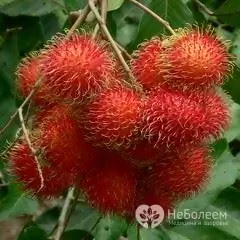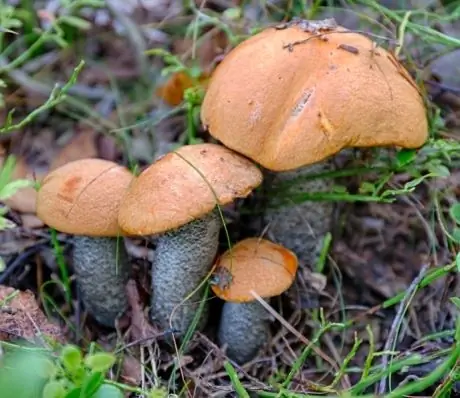- Author Rachel Wainwright [email protected].
- Public 2023-12-15 07:39.
- Last modified 2025-11-02 20:14.
Rambutan
Rambutan is an evergreen tropical tree from the Sapindov family. The name of the plant has Indonesian roots - rambut means "hair". The Malay Archipelago is believed to be the birthplace of rambutan. The appearance of rambutan is not entirely familiar to us, resembling small nuts covered with red or white skin with hard long hairs. However, the fruits of rambutan, with a tender and juicy jelly-like pulp, more than compensate for its unsightly appearance.
The ratio of BJU in the product

Source: depositphotos.com How to burn 82 kcal?
| Walking | 21 minutes |
| Jogging | 9 minutes |
| Swimming | 7 minutes |
| A bike | 12 minutes |
| Aerobics | 16 minutes |
| Household chores | 27 minutes |
Rambutan fruits reach a length of 4-5 cm and are located on the branches in clusters, 10-30 pieces each. As it ripens, the color of the fruit varies, changing color from green to bright red.
Rambutan grows as a wild or cultivated plant in countries with tropical climates - Indonesia, Malaysia, Thailand, Africa, Australia, Southeast Asia, however, the most extensive plantations of the plant are located in Sri Lanka, Cambodia, Indonesia, India, the Philippines.
The fruit is especially popular in Thailand: the indigenous people tell many beautiful legends about rambutan, and in August they celebrate a holiday dedicated to this undersized and unremarkable tree.
Inside the rambutan there is a large edible oval bone, which tastes like a forest acorn. Raw rambutan seeds are poisonous, however, after frying they can and should even be eaten: the fruit seeds contain oleic and arachidonic acids (biologically active substances that play an important role in the body's work).
The fruits of the plant are stored in the refrigerator for no more than one week, and are recommended for consumption immediately after purchase.
Using rambutan
Rambutan is widely used in cooking. Despite the fact that the fruits of this exotic fruit are eaten mostly fresh, canning rambutan with sugar, making jam and jelly based on it, filling for pies and other confectionery products are common. Also, the fruit is used as an appetizing additive to ice cream, sauces, salads, poultry dishes and a variety of drinks. Peeled rambutan can be used to make not only juice or compote, but also sparkling wine.
To use it, remove the hairy skin from the fruit with a knife, then strictly along the seam divide it into two halves. If the peel does not separate well from the rambutan, this means that the fruit is overripe, and it is not recommended to use it inside: in this state it contains many tannins.
The roots, leaves and dried peel of rambutan are used in folk medicine, sold in pharmacies as a medicine.
The oil obtained from the seeds of the plant is used to make soaps, cosmetic products, as well as exclusive holiday candles.
Rambutan shoots are used in the textile industry as a raw material for the production of dyes for silk fabrics in yellow, green, red and black colors.
Useful properties of rambutan

Rambutan pulp contains a complex of substances useful for the body: proteins, proteins, macronutrients, trace elements and vitamins. The red skin of the fruit contains B vitamins, vitamin C, famous for its antioxidant properties, nicotinic acid, as well as macro and microelements: iron, phosphorus, calcium, sodium, zinc, magnesium, potassium, carbohydrates. It is believed that regular consumption of rambutan has a beneficial effect on the functioning of the digestive tract, improves the condition of the skin and hair, and improves immunity. The high content of niacin in the fruit helps to lower blood pressure.
The beneficial properties of rambutan are based on the antibacterial and anthelmintic effects of the fruit, and therefore it is recommended to use the fruits of the plant for helminthic infestation, dysentery, infectious diarrhea.
The pulp and hairy skin of rambutan is used as a poultice in the treatment of headaches.
The rich composition of this exotic fruit has built rambutan's reputation for anti-aging effects. The pulp of the fruit is used not only internally, but is also used to prepare nourishing masks that moisturize and saturate the skin with vitamins and microelements.
The plant is extremely beneficial for pregnant women as well as women who are breastfeeding.
Due to the ability of rambutan to have a positive effect on metabolic processes and enzymatic metabolism of the body, the fruit is recommended for use in case of metabolic disorders and obesity.
Asian nutritionists have found that eating five rambutan fruits daily can increase life expectancy and prevent cancer.
The calorie content of rambutan is about 82 kcal / 100 grams of pulp.
Contraindications
Despite the beneficial properties of rambutan, this exotic fruit is not widely popular in our country, therefore, when using rambutan for the first time, especially by children, it is necessary to use small amounts to induce addiction to the fruit. In addition, in practice, there were cases of individual intolerance to the product.
Do not get carried away with rambutan for people suffering from gastric ulcer.
Found a mistake in the text? Select it and press Ctrl + Enter.






